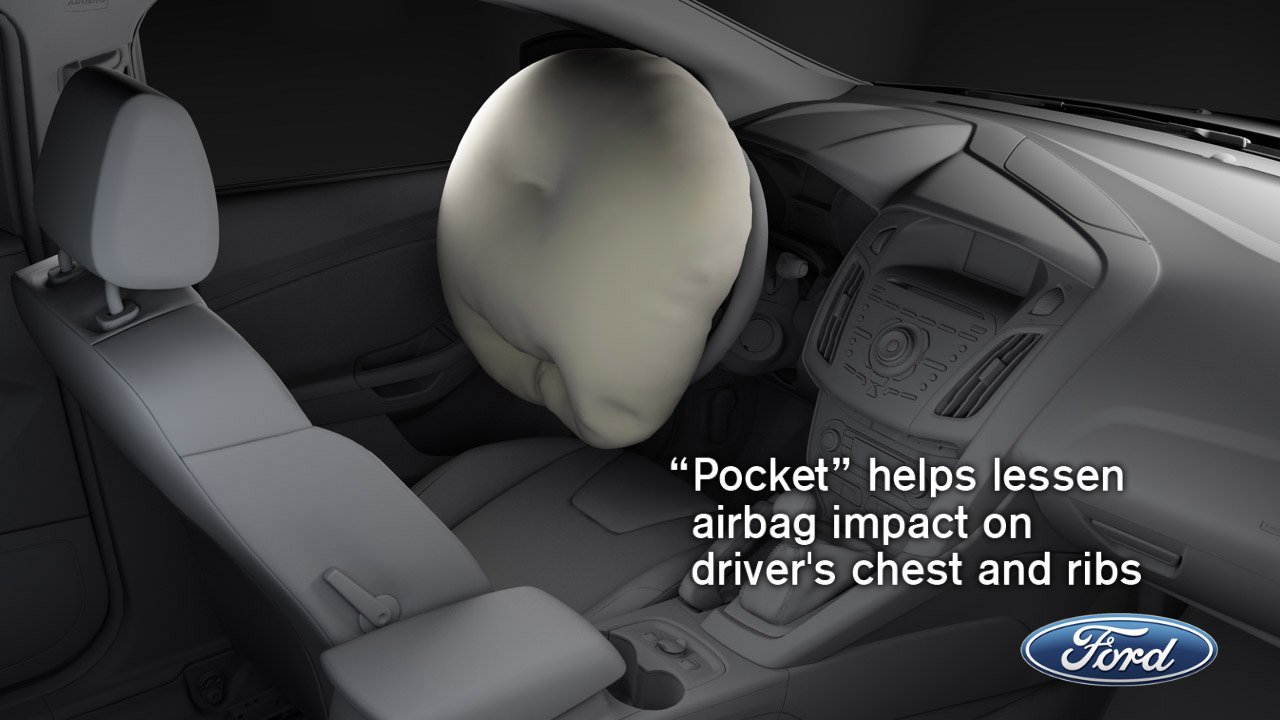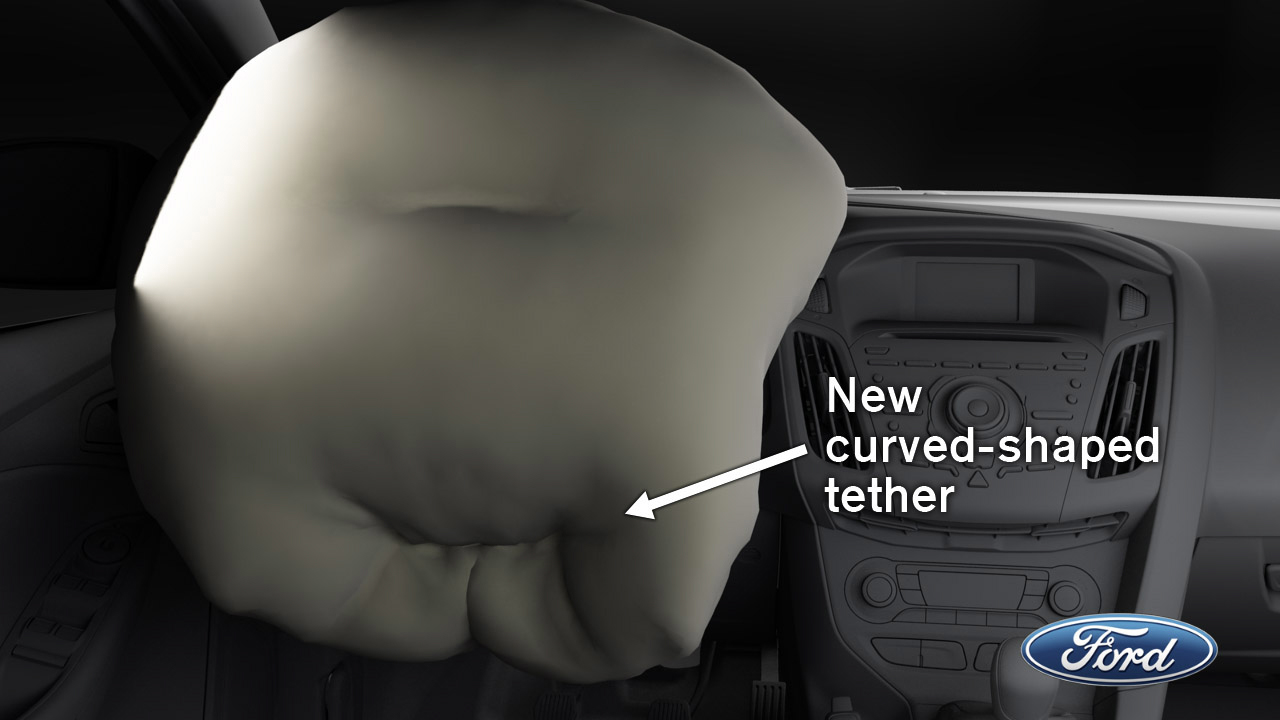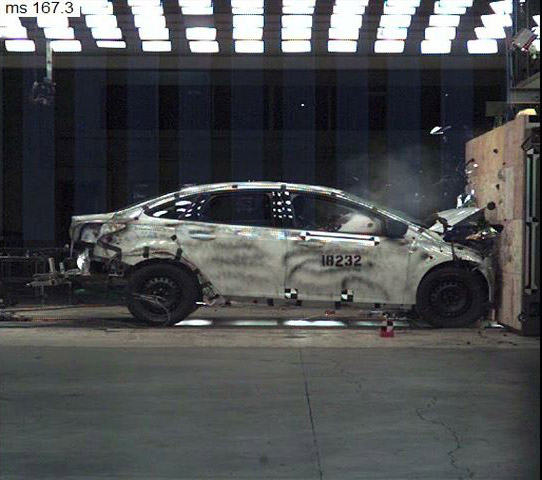|

21-05-2011, 06:17 PM
|
 |
Chairman & Administrator
|
|
|
|
 Ford Focus Crashed 12,000 Times In Virtual And Real World
Ford Focus Crashed 12,000 Times In Virtual And Real World
December 21 2010
* New air-bag technology assists older drivers
* Ford engineers expanded safety testing for the new Focus to prove out its new safety technologies.
* Ford Intelligent Protection System (IPS) features advanced restraint systems
New air-bag technology is part of the latest safety arsenal in the all-new, next-generation Ford Focus.
The driver's front air-bag is designed to provide enhanced chest protection through the use of a reconfigured curved-shaped tether that pulls in the lower section of the air-bag to help lessen the impact of the air-bag on the driver’s chest and ribs.

The feature is expected to be particularly beneficial for older, more injury-prone drivers.
The tethering technology in the driver's air-bag is a first for the all-new Focus in North America and will roll out to many other Ford vehicles in the coming years.

It took more than 12,000 crashes to make the new Focus one of the safest Ford vehicles available globally.
Ford safety engineers in the US and Germany crash tested the new Ford Focus more than 12,000 times in real and virtual worlds to prove out innovative new technologies designed to protect occupants in crashes.
The new Focus, which débuts in Australia in 2011, underwent an exhaustive testing regimen of occupant and full-vehicle computer simulations.
Those simulations were so realistic that the number of physical vehicle crash tests has been significantly reduced.
Focus safety manager, Matt Niesluchowski, said developing the Focus to meet global safety standards had resulted in improved crash performance.
"Ford’s safety team had a head start in working together around the world, which helped tremendously in ensuring the new Focus meets or exceeds a complex web of global safety regulations," he said.
Crashed by Ford to take the heat
The thousands of computer-aided engineering (CAE) crash simulations allowed engineers to test hundreds of designs.
The physical crash tests, conducted after a battery of virtual simulations, verify and validate the computer simulations to ensure every internal and external requirement is met.
"We are using computer simulations more than ever to optimise the designs of all the components that make up a vehicle to help enhance safety,” Niesluchowski said. “The complexity of crash tests, with hundreds of parts and systems interacting, still requires physical testing to validate those simulation results."
Enhanced restraint system
The new Focus features the Ford Intelligent Protection System (IPS), which integrates next-generation restraint system technologies with an optimised high-strength body structure.
IPS has been developed as a closely integrated system, so that the body structure absorbs energy in an effective manner during a crash and works in conjunction with the vehicle's restraint systems to help protect vehicle occupants.
Three-point safety belts are fitted to all seat positions, with retractor pre-tensioners, providing increased retraction travel, along with belt load limiters in the front.
The outer pair of the rear seats has provision for ISOFIX mountings to secure child safety seats.
Focus models feature a new Seat Beltminder system, which not only remind the driver and front seat passenger to use their seat belts, but also alerts the driver if any rear seat passengers do not have their seat belts correctly fastened.
The enhanced restraint system includes individual front air-bags and 3Dside thorax air-bags for the driver and front passenger. The 3D side air-bag is an airbag that is built up from three rather than two panels of fabric and generates more depth.
Standard side curtain airbags for the first- and second-row seats also are featured.
The new air-bag restraint system in the Focus is complemented by other improved interior safety features.
Ford’s horizontal stroking steering column helps to reduce loads on the occupant’s head and chest by diverting these loads away from the driver in the event of a high-speed frontal impact.
This is combined with an instrument panel designed to provide enhanced compliance, helping to protect the occupants legs if they contact the instrument panel during a crash.
Innovative "tailor-rolling" process
In addition, the new Focus’ vehicle structure provides enhanced crash protection with a B-pillar reinforcement, a key structural part made from ultra-high-strength steel produced using an innovative "tailor rolling" process.
This process allows the thickness of the steel sheet to be varied along its length so the component has increased strength in the areas that are subjected to the greatest loads.
High-strength steels comprise 55 per cent of the Focus’s body shell, and ultra-high-strength and boron steels make up more than 31 per cent of its skeletal structure.
These advanced materials help the structure meet crash regulations across world markets while minimising the vehicle's weight to help maximise fuel economy.
Comprehensive suite of active safety technologies
The all-new Ford Focus features a comprehensive suite of advanced active safety technologies to help the driver maintain safe control and avoid accidents.
The Focus is the first Ford vehicle to feature the Low Speed Safety System, which is designed to help drivers avoid the kind of low-speed collisions common in congested urban driving, when a car drives into the rear of the vehicle in front.
A state-of-the-art Electronic Stability Program (ESP) system is at the heart of many of the active safety features, and uses intelligent logic to monitor the vehicle's progress and apply effective – and often imperceptible – intervention when required. The system incorporates:
• Anti Lock Braking (ABS) system including Electronic Brakeforce Distribution (EBD) and Corner Brake Control (CBC)
• Emergency Brake Assist (EBA), Electronic Brake Prefill (EBP) and Emergency Brake Warning
• Traction Control System (TCS) comprising Engine Traction Control System (ETCS) and Brake Lock Differential (BLD)
• Hydraulic Rear-Axle Boost (HRB)
• Engine Drag torque Control (EDC)
• Torque Vectoring Control (TVC)
• Hill Start Assist
• Trailer Sway Control
Many of these features will be available on the Focus for the first time in many markets.
Specifications and equipment details of the next-generation Focus will be revealed closer to its Australian launch.

|


Be The First